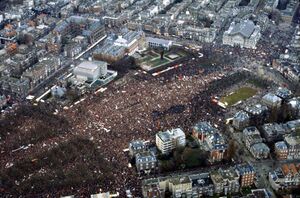Difference between revisions of "1981 Dutch Cabinet crisis"
m (Added ON and theory.) |
m (Ref fix) |
||
| Line 27: | Line 27: | ||
After Van Agt was put out of power a lot of [[privatization]] was slowly introduced. | After Van Agt was put out of power a lot of [[privatization]] was slowly introduced. | ||
| − | Lubbers - coming from the same party as Van Agt - had the eerie title of being PM of the same party that headed the last coalition, something that had not happened since [[1965]] when Gladio-agents from the [[Dutch Deep state]] were implicated in having attempted to assassinate Prime-Minister Cals. | + | Lubbers - coming from the same party as Van Agt - had the eerie title of being PM of the same party that headed the last coalition, something that had not happened since [[1965]] when Gladio-agents from the [[Dutch Deep state]] were implicated in having attempted to assassinate Prime-Minister Cals.<ref>https://www.groene.nl/artikel/versnipperde-geschiedenis</ref> |
All [[Dutch Prime Ministers]] since 1982 have visited the Bilderberg: ([[Ruud Lubbers]] (1982-1994), [[Wim Kok]] (1994-2002), [[Jan Peter Balkenende]] (2002-2010), [[Mark Rutte]] (2010-). | All [[Dutch Prime Ministers]] since 1982 have visited the Bilderberg: ([[Ruud Lubbers]] (1982-1994), [[Wim Kok]] (1994-2002), [[Jan Peter Balkenende]] (2002-2010), [[Mark Rutte]] (2010-). | ||
Revision as of 09:42, 1 November 2020
 | |
| Date | 1981 - 1982 |
|---|---|
| Location | The Hague, the Netherlands |
| Planners | Dutch Deep State, Juliana Wilhelmina, Victor Halberstadt, Cees de Galan, Ruud Lubbers? |
| Interest of | Operatiën en Inlichtingen |
In October 1981, Juliana[1] appointed deep politicians Victor Halberstadt and Cees de Galan to mediate the Dutch Cabinet crisis, this crisis originally was presented by the original narrative as a feud between the PM and progressive Dries van Agt and his CDA-fraction and the socialists in the coalition headed by deputy prime-minister "left"-wing Joop den Uyl and his PVDA party. Following the 1973 Oil crisis and the major inflation and loss of jobs, the two could not reach an agreement on social reforms. Other forgotten details include the participation of the NATO Double-Track Decision of 1979, PVDA members wanted to participate in a protest in 1981 with 400.000 civilians in Amsterdam as other protests regarding the Iran-Iraq war and the 1980s Afghan war were also becoming political hot topics.[2] In a country suffering from pillarisation[3] and the Dutch massive spikes in (at that time legal) drug trade, many overlook the lines connecting what may have been a coup.
Official Narrative
Following the massive peace-protests Wikipedia writes: "Mainly as a result of these plans and the dissatisfaction with the nuclear weapons policy, the Provincial Council elections for the PvdA held on 24 March 1982 were dramatic. The party lost eight percent compared to 1981. D66 also deteriorated. Opposition party VVD, on the other hand, won enormously and even became the country's second party. The election defeat further reduced the PvdA's willingness to compromise. As a result, that party was not only opposed to the CDA, but also to its former ally D66."
Theories
Another theory regarding this crisis was that Van Agt was removed by the Dutch Deep state that backed Den Uyl (who has a picture in his bedroom and is a close friend of Israeli PM Golda Meir) who was PM from 1973 until 1977 and was a supporter of Israel as van Agt was deemed "too risky". Van Agt's is most known for his outspoken or sometimes explosive character; he remarked in the 1970s that the last remaining known Dutch convicted Nazi's in prison should be released because he did not consciously experienced the war and "was arian",[4] he relocated the Dutch embassy to Tel Aviv and told Dutch media in 1982 that "Israel must not think that with provocations and attacks it will reach peace (...) as with gun-violence, unilateral acts and breaking international law and not complying with decisions made by the international community, such as those that have been enacted by the UN" and actively supported sending and keeping UN-troops in Lebanon during the 1982 Lebanon War. Van Agt became a staunch supporter of Palestine and hard critic of Israel and remained it well into the 2020s.[5] Meanwhile Joop den Uyl spoke on the Jerusalem Conference on International Terrorism as the speaker for the "Dutch response" to "terrorism".
Van Agt is the only PM along with Jan Peter Balkenende who has not been "promoted" to the eerie title of Dutch Minister of State, nobody giving an explanation why. Balkenende and the accusations by anonymous aides against him "he did not 'defend' the Dutch royals when Klaas Bruinsma and Mabel van Oranje got connected" and being the reason Balkenende is also banned from ever becoming promoted raises further suspensions.[6]
Deep State
Interestingly enough Van Agt's cabinet had a lot of politicians connected to deep state milleu not known at that time, Van Agt; 1 time bilderberg, Max van der Stoel - head of the Dutch-Gladio division from 1982, Hans van Mierlo - 1 time bilderberg, started - with the future mayor of Amsterdam - a "shadow government" modelled on the British in 1971, publicly advocated for nuclear weapons agains the Sovjet Union[7] and Hans van den Broek alongside Joop den Uyl. After Van Agt was put out of power a lot of privatization was slowly introduced.
Lubbers - coming from the same party as Van Agt - had the eerie title of being PM of the same party that headed the last coalition, something that had not happened since 1965 when Gladio-agents from the Dutch Deep state were implicated in having attempted to assassinate Prime-Minister Cals.[8] All Dutch Prime Ministers since 1982 have visited the Bilderberg: (Ruud Lubbers (1982-1994), Wim Kok (1994-2002), Jan Peter Balkenende (2002-2010), Mark Rutte (2010-).
References
- ↑ https://www.delpher.nl/nl/kranten/view?coll=ddd&identifier=ABCDDD:010879825:mpeg21:a0074
- ↑ https://www.parlement.com/id/vg09llgz6ywn/a_a_m_dries_van_agt
- ↑ https://www.palgrave.com/gp/journal/41295
- ↑ https://www.hpdetijd.nl/2010-05-04/nijmeegse-joden-zitten-niet-te-wachten-op-dries-van-agt/
- ↑ https://www.youtube.com/watch?v=tFsxRnyhOU4
- ↑ https://www.ad.nl/politiek/waarom-balkenende-nooit-minister-van-staat-zal-worden~a4fc3981/
- ↑ https://en.wikipedia.org/wiki/Den_Uyl_Shadow_Cabinet
- ↑ https://www.groene.nl/artikel/versnipperde-geschiedenis